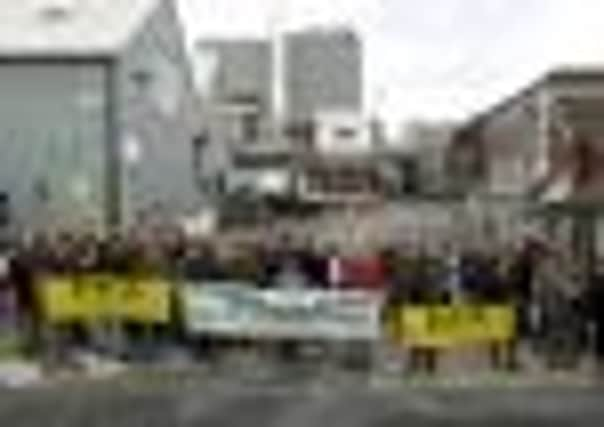Farmers are coming together to show their anger at milk prices


There was a time when dairy farmers produced milk and it was sold on the back of a horse and cart. If you ever watch old films, as I do, you will see that this was still very much the case in the mid-60s. Norman Wisdom’s film The Early Bird highlighted the change from horse-drawn to milk floats. There never seemed to be a problem with the price a farmer was getting for his milk back then.
Doorstep delivery is of course no longer what it was and the move toward buying milk from supermarkets has long since changed the whole face of the dairy industry.
Advertisement
Hide AdAdvertisement
Hide AdThe power over the price a farmer receives for his milk is now determined far more by supermarkets than the processing dairy, and that’s where Stephen Wyrill of Leases Farm, near Richmond, is currently involved in campaigning to achieve a better price and better conditions for farmers to trade their milk.
Up until 1994 individual dairy farmers did not have to worry about their milk price. The Milk Marketing Board sold their milk to the processors. It was a relatively happy situation as it offered all dairy farmers, regardless of where their farm was situated, whether close to a dairy or not, a similar price. The processors were also largely happy as they only had one body to deal with and relationships had been long-standing.
The break-up of the Milk Marketing Board, due to European directives over monopolistic situations, splintered the whole industry.
Processors cherry-picked those farmers where they did not have long hauls to deal with and where a tanker had the minimum of pick-ups. They paid premium prices to bring farms on board and then subsequently sought to find ways of bringing the price down that they paid to them.
Advertisement
Hide AdAdvertisement
Hide AdNineteen years on and there is still a largely unhealthy relationship between supermarkets, processors and dairy farmers. The current price Stephen Wyrill receives is around 29.5 pence per litre (ppl) before the dairy takes off any deductions it can come up with, and yet the regular price of a litre of whole milk in a supermarket is presently around £1.
“Our prices haven’t matched the full cost of production in years, and we’re not the only ones by a long way. We have to scrimp and save in order to get something like a decent margin. Last year the price paid for milk suffered in both the spring and summer and it led to angry exchanges at the Great Yorkshire Show. We were at 31.5ppl this time last year.”
Stephen has 120 dairy cows on his 385 acre farm just off the A1. He’s also the national vice chairman of the Tenant Farmers Association. Last year he was involved with the set-up of a dairy farming coalition that is looking to organise fairer practices in the industry. It comes as no surprise that the processing dairies are dragging their heels in coming up with solutions.
“We have representatives from our own Tenants Farmers Association, the National Farmers Union, Country Landowners Association, the Royal Association of British Dairy Farmers and Farmers For Action. We are meeting regularly and we feel that we have made some progress.”
Advertisement
Hide AdAdvertisement
Hide AdThe most notable organisation involved in the coalition is Farmers For Action, led by David Handley.
“When farmers get angry and want to demonstrate their feelings it needs to be organised. David is the man for the job. You don’t need some kind of vigilante, you need someone who listens to farmers as we do but can say things independently.
“Farming hasn’t always had a good press and the coalition is determined that we won’t be involved in any scuffles on picket lines. Our demonstrations have been good-natured and well mannered. We had one time in autumn when 300 dairy farmers were demonstrating together and there seemed an equal number of police in their battle dress. As they came to split up the demonstration all the farmers sat down and this baffled them. It wasn’t long before everyone started bursting out laughing. We want the public on our side in the same way.”
Stephen still finds that the public is very receptive to the facts and appreciative of dairy farmers’ plight.
Advertisement
Hide AdAdvertisement
Hide Ad“When I meet people in my local shop I always get asked about the milk price I’m getting and they will invariably say how ridiculous it is that we get so little of a share when we are providing the actual product. The ironic thing is that they might sometimes say that their milk has just increased in price, and yet we see none of that passed back.
“We are with Arla at present and they calculate your monthly average production on just one month of the year, October. It’s one of the worst months of the year to choose because your production is generally down on the summer months.
“That means that when you get back around to May you could be facing as much as 6.5ppl deductions for over-production of your October average. I can understand the need for matching supply with demand but it all looks to me, being a cynic, that all they are after is buying our milk as cheaply as possible.”
Fears for the sector’s future
Stephen’s current herd average is just under 10,000 litres per cow. He doesn’t see himself leaving the industry but he’s clear enough about his future. “Dairy farmers cannot survive on thin air. Dairying suits my farm and I have just invested in some new equipment but I cannot produce milk without getting a return. And if I can’t get the price I want, and the coalition can’t achieve it either, then what hope is there for the future of dairy farming?”